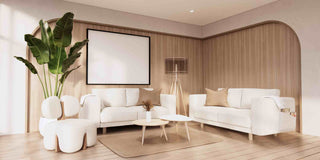Muji interior design is an innovative concept that has taken the design world by storm. It is a Japanese minimalist approach to interior design that focuses on simplicity, functionality, and the use of natural materials.
Muji, which stands for Mujirushi Ryohin, which translates to "no-brand quality goods", is a design philosophy that seeks to create a serene and peaceful living environment by eliminating clutter and excess.
The Philosophy Behind Muji Home Interior Design: Simplicity and Functionality

At the heart of the Muji interior design philosophy is the belief that a simplified lifestyle can lead to a more fulfilling life. This design approach emphasises the use of natural materials and a minimalist aesthetic to create a peaceful and uncluttered living space. By reducing clutter and unnecessary possessions, Muji aims to create a space that is both calming and practical.
Creating a Minimalist and Relaxing Space with Muji Interior Design

The Importance of Natural Materials in Muji Interior Design
Muji interior design emphasises the use of natural materials to create a peaceful and inviting living space. From the muji furniture to the decor, natural materials are at the heart of Muji style home, and for good reason.
Natural materials have a number of benefits, including their durability, sustainability, and ability to create a warm and cosy atmosphere. Here are some natural materials that you can infuse in your Muji-inspired HDB space.
Wood
Wood is one of the most commonly used natural materials in Muji interior design because it is valued for its durability, timeless beauty, and ability to bring warmth to a space. Additionally, Muji spaces often feature furniture made from light-colored woods, such as oak, birch, ash, or maple, that have a minimalist and timeless aesthetic. Lastly, if you are planning to create a muji living room, wood is one of the important element that can give calm and relaxing accent to your space. (Tip: Muji TV console can be a great addition to your muji style living room)
Stone
Stone is another natural material that is valued for its texture and natural beauty, and can be used to create a sense of harmony and balance in a space. Stone tiles or countertops can be used in the kitchen or bathroom, while larger stone features, such as accent wall that can add a dramatic focal point to a living space.
Cotton
Cotton and linen are also commonly used in Muji interior design. These natural materials are prized for their softness, breathability, and natural texture and they can be used in bedding, curtains, and upholstery to create a cosy and inviting atmosphere.
Muji-Inspired Furniture: Practicality and Timelessness

Are you already planning to purchase that most-coveted muji desk or muji dressing table you saw from your favourite furniture shop or that trendy bean bag Singapore muji that everyone is talking about? Before you hop into your furniture shopping spree, let's see what we have here for you.
Muji-inspired furniture prioritises practicality and timelessness over trends or flashiness, resulting in pieces that are both functional and beautiful.
Minimalism
Furniture with its minimalist design that is often characterised by clean lines, simple shapes, and a lack of unnecessary ornamentation is one of the key features of Muji-inspired furniture (e.g. muji side table). This minimalist aesthetic allows the furniture to blend seamlessly into a variety of interior styles and ensures that it will remain stylish and relevant for years to come.
Functionality
Muji-inspired furniture pieces are also known for their functionality. Each piece is designed with a specific purpose in mind, and often includes hidden storage solutions or multi-functional features because this practicality ensures that the furniture is not only beautiful but also useful, making it a worthwhile investment for any home.
Natural Materials
The use of natural materials is also a key feature of Muji-inspired furniture. From the light-coloured woods used in tables and chairs to the woven textures of rattan or wicker, natural materials are used to create furniture that feels warm and inviting.
Creating a Serene and Soothing Atmosphere

Muji interior design is known for its ability to create a serene and soothing atmosphere in any space. With its focus on simplicity, natural materials, and functional design, Muji-style interiors can promote feelings of calm and relaxation.
One of the key features of Muji interior design that contributes to its serene atmosphere is its use of neutral colours. Shades of white, beige, and grey are commonly used to create a calming, understated aesthetic because this muted colour palette allows for the focus to be on the natural textures and materials used in the space, creating a sense of warmth and comfort.
Creating a Tranquil Muji Living Room
The Muji living room embodies tranquillity and simplicity, serving as a space for relaxation and connection. Incorporating Muji interior design principles into your living room can transform it into a serene sanctuary where you can unwind after a long day. Here's how you can achieve a tranquil Muji living room:
1. Muji Table as the Focal Point: A Muji table, characterized by its minimalist design and natural materials, can serve as the focal point of your living room. Whether it's a coffee table or a dining table, opt for a simple yet elegant design crafted from light-coloured wood like oak or ash. The Muji table's clean lines and functionality will complement the serene ambience of your space.
2. Neutral Colour Palette: Embrace a neutral colour palette consisting of soft tones such as white, beige, and light grey for your walls, furniture, and decor. These muted hues create a calming backdrop that allows the natural textures of your Muji-inspired furnishings to shine through, fostering a sense of tranquillity in your living room.
3. Cozy Seating Arrangement: Arrange seating in your Muji living room to promote relaxation and conversation. Opt for comfortable yet streamlined seating options like floor cushions, low-profile sofas, or minimalist armchairs upholstered in natural fabrics such as cotton or linen. Create an inviting atmosphere by incorporating plush throws and cushions in soothing earthy tones.
4. Natural Elements: Integrate natural elements like indoor plants, stone accents, and wooden decor pieces to bring a touch of nature indoors. A strategically placed stone sculpture or a cluster of potted plants can add visual interest and enhance the organic feel of your Muji living room, contributing to its tranquil ambience.
5. Decluttered Space: Keep your Muji living room clutter-free by embracing minimalist decor and storage solutions. Opt for sleek storage units, such as Muji shelves or cabinets, to stow away belongings and maintain a clean and organized environment. Minimize decorative accents to essentials that serve a purpose, promoting a sense of serenity and space in your living room.
The Benefits of Muji Interior Design for Your Mental Well-being

Reduced Clutter
Muji interior design encourages a clutter-free environment, which can help reduce stress and anxiety because luttered spaces can cause a sense of overwhelm and make it difficult to relax or focus. By simplifying your surroundings, you create a calm and organised atmosphere that promotes a sense of tranquillity.
Increased Mindfulness
Muji interior design encourages you to be more mindful of your surroundings by removing unnecessary items and focusing on functionality, you become more aware of the objects and spaces around you. This mindfulness can help you stay present and engaged in the moment, which can reduce stress and increase your overall well-being.
Natural Materials
Muji interior design incorporates natural materials such as wood, cotton, and linen because these materials are known for their calming and grounding effects, which can help reduce stress and anxiety. Additionally, natural materials also create a sense of warmth and comfort, making your home feel like a sanctuary.
Better Sleep
Muji style bedroom or muji inspired bedroom emphasises the importance of a good night's sleep by creating a calm and peaceful bedroom environment, you can improve the quality of your sleep. Muji bed (or if you have muji loft bed) requires a muji bedding, which is made from natural materials, is designed to promote restful sleep and help you wake up feeling refreshed. Additionally, a muji bed frame design is also helpful to achieve the tranquil ambience to your bedroom.
Improved Focus
Muji interior design encourages a minimalist approach to decor, which can help improve your focus and productivity because when your space is free of distractions, you can concentrate more effectively on your work or hobbies and this can lead to increased creativity, better problem-solving skills, and a greater sense of satisfaction in your accomplishments.
Making the Most of Your Home with Muji Interior Design

Muji interior design is a practical and versatile way to make the most of your home. By focusing on functionality, organisation, and natural materials, a Muji-style interior can help you create a space that is both efficient and enjoyable to live in. So whether you have a large house or a small apartment, a Muji-style interior can be tailored to fit your space and your needs.
Overall, Muji interior design is a great way to make the most of your home that supports your well-being and helps you make the most of your living space.



